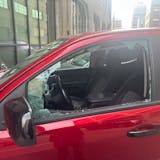What happened: The storm of legend, the Armistice Day blizzard.
When: Nov. 11, 1940.
A disarming start: In the Twin Cities area, it started as an unseasonably warm day. By the afternoon, temperatures were in the 60s. That changed quickly when the massive cold front moved in. More than 1,000 miles wide, the storm claimed 145 lives in several states by the time it was over on Nov. 12. In Minnesota, 49 people died. Parts of the state were blanketed in more than 2 feet of snow.
In the headlines: The Star Journal's headline tells the story of the storm: "City, Northwest Buried by Worst November Storm; Death Toll Rises; Many Still Lost; Cold to Continue."
The lost, the rescued: Two members of a family of five were found frozen in their stalled car, 5 miles from Mankato. There was a 30-car pileup on a highway near New Brighton. Twelve streetcars stalled at Lake Street and Hennepin Avenue in Minneapolis. As many as 250 men, women and children were forced to bunker overnight in their cars near Glencoe.
Duck hunters were hit hardest — 38 perished in the Mississippi River bottoms. Two were rescued on the 12th. "It wasn't so bad being without food," one of the survivors told the newspaper. "But we had only five cigarettes." His hunting partner, the story noted, returned to the hunt the next day.
Two of the lucky ones: Not all the news was grim. Two cousins, ages 5 and 15, went to the movies in downtown Minneapolis just as the storm began and stayed for a double feature. When they left the theater, they found the world transformed — and no streetcars. The 15-year-old carried the younger child 12 blocks, but became exhausted. He managed to find a phone and called home.
His mother knew someone downtown, Billy Hoke, a wrestling promoter. Hoke arranged to have the kids stay the night at the Hotel Dyckman, on 6th Street between Nicollet and Hennepin avenues, later the site of City Center. (The hotel was demolished in 1979.) According to the newspaper story, the two dined "regally" and had a pillow fight.


